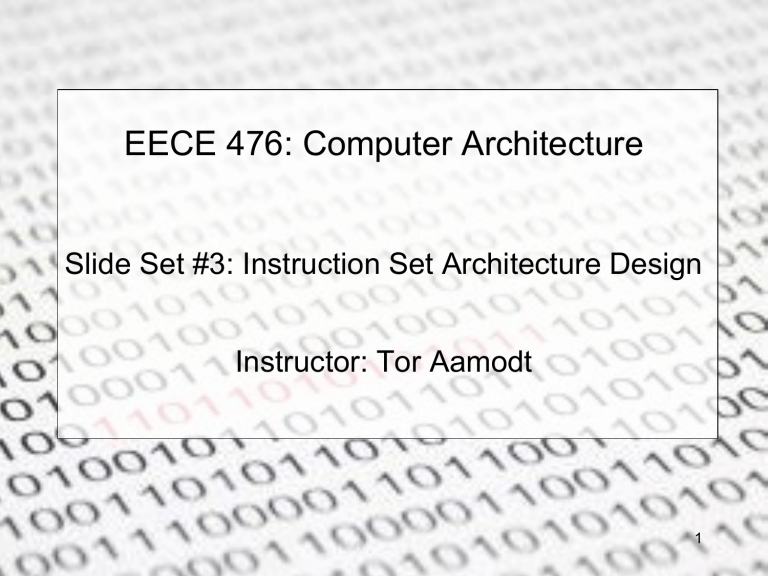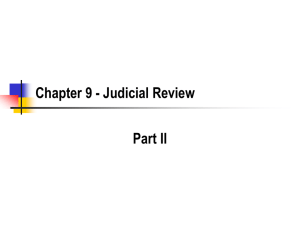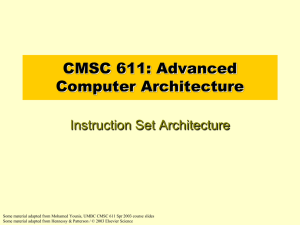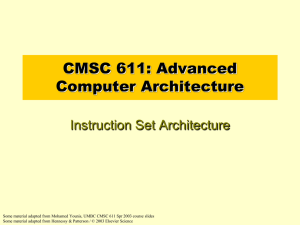Slide Set #3

EECE 476: Computer Architecture
Slide Set #3: Instruction Set Architecture Design
Instructor: Tor Aamodt
1
In the news yesterday…
Apple iPhone 5S
(64-bit ARM)
Intel Quark X1000
(1/5 size of Intel Atom; x86/pentium)
The RISC vs. CISC Debate
PowerPC 620 “ RISC ” ISA PentiumPro “ CISC ” ISA
(w/ “RISC implementation”)
• RISC = Reduced Instruction Set Computer
• CISC = Complex Instruction Set Computer
• Red portion on Pentium Pro represents overhead of supporting CISC (about 5% area increase)
3
Instruction Set Architecture (ISA)
software instruction set hardware
• The low-level software interface to the computer
– Language the computer understands
– Must translate any programming language into this language
– Examples: ARM, x86, PowerPC, MIPS , SPARC, …
• ISA is the set of features “visible to programmer”
4
Levels of Representation
High Level Language
Program temp = v[k]; v[k] = v[k+1]; v[k+1] = temp;
Compiler
Assembly Language
Program
LW R15,0(R2)
LW R16,4(R2)
SW R16,0(R2)
SW R15,4(R2)
Assembler
Machine Language
Program
1000 1100 0110 0010 0000 0000 0000 0000
1000 1100 1111 0010 0000 0000 0000 0100
1010 1100 1111 0010 0000 0000 0000 0000
1010 1100 0110 0010 0000 0000 0000 0100
Machine Interpretation
Control Signal
Specification
°
°
ALUOP[0:3]
←
InstrReg[9:12] & MASK
5
/* file: t.c */
void foo( int *q, int *p )
{
int x=0;
if( p ) { x = *p; }
*q = x;
}
$ sslittle-na-sstrix-gcc -O2 -S t.c -o t.s
$ sslittle-na-sstrix-as t.s -o t.o
$ sslittle-na-sstrix-objdump --disassemble t.o
t.o: file format ss-coff-little
Disassembly of section .text:
00000000 <foo>:
0: 42 00 00 00 addu $2,$0,$0
4: 00 02 00 00
8: 05 00 00 00 beq $5,$0,18 <__gnu_compiled_c+0x18> c: 02 00 00 05
10: 28 00 00 00 lw $2,0($5)
14: 00 00 02 05
18: 34 00 00 00 sw $2,0($4)
1c: 00 00 02 04
20: 03 00 00 00 jr $31
24: 00 00 00 1f
.file 1 "t.c”
...
__gnu_compiled_c:
.text
...
foo:
...
move $2,$0 beq lw
$5,$0,$L2
$2,0($5)
$L2: sw j
$2,0($4)
$31
.end foo
6
Review: Scientific Notation
Examples…
• 2.9979245
×
10
8
(speed of light)
• 6.0221413
×
10
23
(Avogadro’s number)
• 1.3806488
×
10
-23
(Boltzmann constant)
7
•
Review: Floating-Point
Slide Set 11, Page 8
•
Slide Set 11, Page 9
•
Slide Set 11, Page 10
Review: Hex Notation
• Often use “hex” notation (base 16 instead of base 10)
• Digits: 0,1,2,3,4,5,6,7,8,9,A,B,C,D,E,F
• Example 1: 0xF = 15
10
• Example 2: 0x12 = 18
10
= 01111
= 10010
2
2
11
Example ISA: MIPS
• Use MIPS64 subset in examples in course
• Similar to “PISA” ISA used in assignments
• Syntax used in class, problem sets & tests is simplified versus used by compiler
12
MIPS Registers
32 generalpurpose registers R0, R1, … R31
• Each contains 64-bits (8 bytes)
• NOTE: Value of R0 is always 0
• Notation: Regs[R3] is 64-bit value in R3.
32 floatingpoint registers, F0, F1, … F31
• Either a 32- bit or 64-bit floating-point number
Special Register: PC (program counter)
13
0x0002
0x0001
0x0000
‘o’
‘o’
‘f’
Address Data
Memory
32 registers not enough to store data for useful programs.
All computers have “random access memory” (RAM) that is used to store data.
To get data, need to know it’s address.
Also store instructions in memory.
14
Notation
Regs[Rn]
Mem[Addr]
##
<-
Superscript
Subscript
Example Instruction
DADDU
DADDIU
LUI
DSLL
DSLT
R1,R2,R3
R1,R2,#3
R1,#42
R1,R2,#5
R1,R2,R3
Example MIPS64 ALU instructions
Contents of register “n”
Contents of memory at location “Addr”
Concatenate bits
Means assign right hand side to location on left hand side
Replicate a field (0 16 is a 16-bit field with all zeros)
Selection of bit (most significant bit = 0)
Instruction Name
Add unsigned
Add immediate unsigned
Load upper immediate
Shift left logical
Set less than
Meaning
Regs[R1] <- Regs[R2]+Regs[R3]
Regs[R1] <- Regs[R2]+3
Regs[R1] <- 0 32 ##42##0 16
Regs[R1] <- Regs[R2] << 5 if( Regs[R2] < Regs[R3] )
Regs[R1] <- 1 else Regs[R1] <- 0
15
MIPS Load/Store instructions
Example Instruction
LD
LW
SW
L.S
L.D
R1,30(R2)
R1,60(R2)
R3,500(R4)
F0,50(R3)
F0,50(R2)
Instruction Name
Load double word
Load word
Store word
Load FP single
Load FP double
Meaning
Regs[R1] <-
64
Mem[30+Regs[R2]]
Regs[R1] <-
64
(Mem[60+Regs[R2]]
0
) 32 ##
Mem[60+Regs[R2]]
Mem[500+Regs[R4]] <-
32
Regs[R3]
Regs[R0] <-
64
Mem[50+Regs[R3]] ## 0 32
Regs[F0] <-
64
Mem[50+Regs[R3]]
16
Typical Example
C code: int x = 0; if(p!=NULL) { x = *p; }
*q = x;
MIPS64:
; x : R2, p : R5, q : R4
DADDI R2,R0,#0
BEQ R5,R0,L2
LW
L2: SW
R2,0(R5)
R2,0(R4)
17
MIPS Control flow instructions
Terminology we will use:
Jump = unconditional change of control flow
Branch = conditional change of control flow
Example Instruction
J
JAL name name
JALR
JR
BEQZ
R2
R3
R4,name
BNE
MOVZ
R3,R4,name
R1,R2,R3
Instruction Name
Jump
Jump and link
Jump and link register
Jump register
Branch equal zero
Branch not equal
Meaning
PC
36..63
<-name
Regs[R31] <- PC + 4; PC
36...63
<-name
Regs[R31] <- PC + 4; PC <- Regs[R2]
PC <- Regs[R3] if( Regs[R4] == 0 ) PC <- name if( Regs[R3]!=Regs[R4] ) PC <- name
Conditional move if zero if( Regs[R3]==0) Regs[R1] <- Regs[R2]
18
MIPS Instruction Encoding
Need some way to represent
(or “encode”) an instruction as
1’s and 0’s to communicate with computer.
•
All instructions 32 bits wide
•
All instructions perform simple operations
•
Only three instruction formats for all instructions
•
Opcode specifies what operation to perform.
• “rs”, “rt”, “rd” fields indicate registers to read and/or write.
19
Example of Encoding MIPS64
The following assembly code
DADD R1,R2,R3
Is translated into:
000000 0010 0011 0001 00000 101100
20
Millions of
Processors
Why MIPS?
Year
“RISC”
21
Why MIPS?
• Today: MIPS still used in embedded microprocessors.
• History: Developed at Stanford (by current Stanford President). In fast microprocessors of mid90’s (e.g., MIPS R10000).
• MIPS is a Reduced Instruction Set Computer (RISC) ISA just like
ARM, SPARC, PowerPC. Arguably simpler so more suitable when learning principles.
22
Why MIPS?
• MIPS64 is representative of all RISC architectures
– i.e., if you understand one, learning another one is very easy
• x86 today -> uses RISC internally
– (ANY ISA that isn’t RISC would use RISC internally if you wanted high performance)
• RISC roots -> CDC 6600 and Cray-1
• 1st RISC microprocessors: IBM 801, Berkeley RISC, Stanford
MIPS
23
Example 2: ARM
24
Instruction Encoding
ADD immediate
25
Elements of an ISA
• Set of machine-recognized data types
– bytes, words, integers, floating point, strings, . . .
• Operations performed on those data types
– Add, sub, mul, div, xor, move, ….
• Programmable storage
– Registers, program counter, memory
• Methods of identifying and obtaining data referenced by instructions
(addressing modes)
– Addressing modes: Literal, register, absolute, relative, reg + offset, …
– Endianness, alignment restrictions
• Format (encoding) of the instructions
– Op code, operand fields, …
Current Logical State of the Machine
Next Logical State of the Machine
26
Four ISA Classes
27
Four ISA Classes
How to compute “C = A + B”:
Stack
Push A
Push B
Add
Pop C
Accumulator
Load A
Add B
Store C
Reg/Mem
Load R1,A
Add R3,R1,B
Store R3,C
Reg/Reg
Load R1,A
Load R2,B
Add R3,R1,R2
Store R3,C
28
Question
• Assume A, B, and C reside in memory. Assume opcodes are 8bits. Memory addresses are 64-bits, and register addresses are
6-bits (64 registers)
• For each class of ISA, how many addresses or names appear in each instruction for the code to compute C = A + B, and what is the total code size?
29
Four ISA Classes
Stack
Push A
Push B
Add
Pop C
Accumulator
Load A
Add B
Store C
Reg/Mem
Load R1,A
Add R3,R1,B
Store R3,C
Reg/Reg
Load R1,A
Load R2,B
Add R3,R1,R2
Store R3,C
• Stack 3 addresses, total bits = 4*8+3*64 = 224 bits
• Accumulator 3 addresses, total bits = 3*(8+64) = 216 bits
• Reg/Mem 3 addresses+4 regs, total bits = 3*64+4*6+3*8 = 240 bits
• Reg/Reg 3 addresses+6 regs, total bits = 3*64+6*6+4*8 = 260 bits
30
Trade-Offs
• Stack
– extra code / memory bandwidth
– hard to “reorder” instructions
+ good code density
• Accumulator
– difficult for compiler
– extra code / memory bandwidth
+ good code density
• Register-Memory
– # of registers may be limited
– operands not equivalent
+ good code density
• Register-Register
- poor code density (more instructions to do same thing)
+ easy to pipeline
+ easy for compiler to generate efficient code
31
Measurement and Evaluation
Design
Analysis
Architecture is an iterative process
-- searching the space of possible designs
-- at all levels of computer systems stack
- B5000,
- picoJava,
- x86 fp accumulator
-MC68HC11 internal storage registers
???
Let’s look at other options when designing an ISA…
MIPS64
32
Memory Addressing
Each data value is stored in memory at a location determined by a “memory address”.
• What does a memory address (and length) mean?
– Byte-addressable (desktop, notebook, server computers)
• Address specifies a multiple of 8-bits (a byte)
• Access power of 2 number of bytes (8-bits, 16-bits, 32-bits, 64-bits)
– Word addressable (often found in embedded processors)
• Word size = number of bits used in arithmetic operations such as addition (8, 16, 24-bits common word sizes for embedded processors)
• Address specifies which “word” to access in memory.
• When reading/writing multiple bytes of data in memory, which order are the bytes put in?
– Little Endian: byte at “xxxxx000
2
• [7 6 5 4 3 2 1 0]
” is least significant
– Big Endian: byte at “xxxxx000
2
• [0 1 2 3 4 5 6 7]
” is most significant
• x86 => little endian
• SPARC/PowerPC => big endian
• MIPS/ARM/IA64/PA-RISC => mode bit
33
Memory Alignment
•
In many architectures (e.g., RISC), addresses must be “aligned”; i.e., (byte address) modulo (length in bytes) = 0
•
For others (x86) there may be performance benefits if accesses are aligned width of object
1 byte
2 bytes (half word)
2 bytes (half word)
4 bytes (word)
4 bytes (word)
4 bytes (word)
4 bytes (word)
8 bytes (double word)
8 bytes (double word)
8 bytes (double word)
8 bytes (double word)
8 bytes (double word)
8 bytes (double word)
8 bytes (double word)
8 bytes (double word)
Value of 3 low-order bits of byte address
0 1 2 3 4 5 6 7
Bad: Two memory accesses required
34
Why Does Alignment Matter?
Consider Memory Hardware…
Programmer’s View: Hardware:
0x0000+0*N:
0x0000+1*N:
0x0000+2*N:
‘f’ ‘o’ ‘o’
0x0002
0x0001
0x0000
‘o’
‘o’
‘f’
Address Data
(N depends upon HW)
35
Partial Register Access
A partial register access reads or writes only a portion of a full register (e.g., update only least low order byte of 32-bit register).
32-bit register: byte 3 byte 2 byte 1 not accessed byte 0 accessed (read/written)
Example: Partial write of 2-byte value 0xABCD to 4-byte (32-bit) register containing 0x12345678 results in 0x1234ABCD
Instruction sets that allow partial register write complicate hardware support for high performance implementations (the reasons why will be more clear later in the course when we talk about pipelining and tomasulo’s algorithm).
Partial register write found on x86 (8-bit => 16-bit => 32-bit)
Also on historical ISAs such as VAX and IBM 360
Partial register write not found in MIPS64 or other RISC ISAs
36
Addressing Modes
• Recall Notation:
– “Regs” is array of N-bit registers
• (for MIPS64, 32x64-bit registers)
• Regs[x] is the 64-bit quantity in register “x”
– “Mem” is array of bytes
• Mem[x] is “m” bytes starting at address “x”
• “m” will be implied by usage
• Terminology:
– “Effective Address” = actual memory address calculated by instruction (just before accessing memory).
37
Addressing Modes
Mode
1.
Register
2.
Immediate
Example
Add R4, R3
Add R4, #3
Meaning
Regs[R4] <- Regs[R4] + Regs[R3]
Regs[R4] <- Regs[R4] + 3
3.
Displacement Add R4, 100(R1) Regs[R4] <- Regs[R4] +
Mem[ 100 + Regs[R1] ]
4.
Register Indirect Add R4, (R1) Regs[R4] <- Regs[R4] + Mem[Reg[R1]]
5.
Indexed Add R3, (R1+R2) Regs[R3] <- Regs[R3] +
Mem[Regs[R1]+Regs[R2]]
38
Addressing Modes
Mode
6.
Direct
8.
Autoincrement
9.
Autodecrement
10. Scaled
Add R1, (1001)
7.
Memory Indirect Add R1, @(R3)
Regs[R1] <- Regs[R1] + Mem[1001]
Regs[R1] <- Regs[R1] +
Mem[Mem[Regs[R3]]]
Add R1,
Add R1,
(R2)+
-(R2)
Regs[R1] <- Regs[R1]+ Mem[Regs[R2]]
Regs[R2] <- Regs[R2] + d
Regs[R2] <- Regs[R2] - d
Regs[R1] <- Regs[R1]+ Mem[Regs[R2]]
Add R1, 100(R2)[R3] Regs[R1] <- Regs[R1] +
Mem[100+Regs[R2]+Regs[R3]*d]
39
Addressing Modes
Lesson: ‘fancy’ addressing modes not used much by compiler simple addressing modes used most often
40
Displacement Mode
• How many bits should be used to encode displacement?
• What are the tradeoffs?
41
Example: How Many Bits?
Imagine a RISC instruction set that supports a 24-bit displacement field and that initially Regs[R1]=0x40. We have a program with the following instruction:
LD R2, 0x10002(R1) ; Eff. Addr. = 0x10002+0x40=0x10042
NOTE: The value 0x10002 requires at least 17 bits to represent.
We can implement the same operation using a16-bit displacement by using multiple instructions. For example, using MIPS64 (which has a
16-bit displacement field):
LUI R3,#1
DADD R4,R3,R1
LD R2,2(R4)
; Regs[R3] = 0x10000
; Regs[R4] = 0x10000+0x40=0x10040
; Eff. Addr = 0x10040+0x2=0x10042
42
Usage of Immediate Operand
• What are implications for ISA design?
43
Question
Assuming any size displacement is allowed, a program contains 25% loads with 50% of these loads having displacement of 8 bits or less and all loads have displacement of 16 bits or less.
1.
If we require length of load to be 16 + displacement size bits, which uses less instruction memory: using (a) 8-bit or (b) 16bit displacements for loads (assuming all other instructions are
16-bits)? If a displacement exceeds the size of the displacement field an additional 16 + displacement size instruction is required.
2.
What if all instructions must have the same “width” in bits?
(i.e., all instructions are (a) all 24-bits or (b) all 32-bits)
44
Answer
45
Type and Size of Operands
• Character (8-bit, 16-bit)
• Signed Integer (64-bit, 32-bit, 16-bit, 8-bit)
– (2’s complement)
• Unsigned (64-bit, 32-bit, 16-bit, 8-bit)
• Single precision floating point (32-bit)
• Double precision floating point (64-bit)
• BCD (binary coded decimal)
• Vertex (4x 32bit floating point)
• Color (RGBA)
• Fixed-point
46
Typical ISA Operations
There are several basic types of operations that are found in most instruction sets. These are listed below.
Data Movement Load (from memory)
Store (to memory) memory-to-memory move register-to-register move input (from I/O device) output (to I/O device) push, pop (to/from stack)
Arithmetic
Shift
Logical
Control (Jump/Branch)
Subroutine Linkage
Interrupt
Synchronization integer (binary + decimal) or FP
Add, Subtract, Multiply, Divide shift left/right, rotate left/right not, and, or, set, clear unconditional, conditional call, return trap, return test & set (atomic read-modify-write)
47
Top 10 IA-32 Instructions
Rank
1
2
3
4
5
6
7
8
9
10
Instruction load conditional branch compare store add and
Integer Average (Percent total executed)
22%
20%
16%
12%
8%
6% sub 5% move register-register 4% call 1% return
Total
1%
96%
• Simple instructions dominate instruction frequency
48
Instructions for Control Flow
• Four basic types
– Conditional Branches
– Jumps
– Procedure Calls
– Procedure Returns terminology (H&P, MIPS64): jump = change in control flow unconditional.
branch = conditional change in control flow.
49
Addressing Modes for
Control Flow Instructions
• Destination (“target”) address:
instr. address
0x0000 LD
0x0004 Loop: LD
0x0008 DADDIU
0x000c
0x0010
0x0014
0x0018
SD
DADDIU
BNE
ADD instruction
R1,0(R5)
R2,0(R1)
R2,R2,#1
R2,0(R1)
R1,R1,#4
R2,R3, Loop
...
“Backwards branch”
50
PC-relative Addressing
• Recall that the “program counter” (PC) provides the memory address of the instruction to execute.
• For PC-relative addressing, we compute the new program counter address by using the address of the branch instruction
(stored in the PC), and adding an offset to this address: destination := (PC of branch) + offset
• Benefits of PC-relative addressing:
1. offset encoded using less bits than PC... why?
2.
“position independence” (helps “linking”, esp. in DLLs)
51
How many bits?
• 8 bits often enough!
52
Destination Register
• PC-relative addressing not helpful if target is not known at compile time.
– procedure return
– indirect jumps
• Use a register to specify destination PC
• Indirect jumps useful for:
– switch statements
– virtual functions (C++, Java)
– function pointers (C++)
– dynamically shared libraries
53
Conditional Branch Options
• Most branches depend upon simple comparisons:
54
Conditional Branch Options
How do we know if a branch should update the PC to the target of the branch? Here are some approaches used in real machines:
• Condition codes: Read a special “flag” bit to determine whether branch is taken. Flag bit set by an earlier instruction.
– Branch condition computed as side effect of earlier instructions
– Benefits: Can reduce instructions
– Drawbacks: Constrains ordering of instructions, can complicate hardware implementation
• Condition register: E.g.,. branch if contents of register non-zero
– Test arbitrary register
– Benefit: better for compiler; easier hardware implementation
– Drawbacks: increases instruction count
• Compare and Branch: Combine comparison with branch
– Benefit: Saves instructions
– Drawback: May increase cycle time
55
Procedure Invocation
While we are talking about control flow instructions, let’s consider how function calls and returns work:
• Key issue: variables local to a function should not be modified by function calls. Such variables are often stored in registers to improve performance.
• Who saves registers on a function call?
– Caller save: Before a “call instruction”, save registers
– Callee save: First thing done when starting a function is to save registers.
• One approach sometimes better than other (depends upon program).
•
In practice: Set agreed upon standard (application binary interface)
• Alternative: Hardware does saving/restoring during call instruction (inefficient).
56
Encoding an ISA
Once we decide which instructions we want, we need to specify the instruction in 1’s and 0’s so that digital logic gates can implement it. This is known as
“encoding” the instruction set.
One important question is whether instructions are all encoded with the same number of bits. The options are “variable” encoding (each instruction can be a different size);
“fixed” encoding (all instruction same), or a “hybrid” (where there may be a limited number of instruction sizes).
Choice influenced by competing forces:
– desire to have large # of registers + addressing modes
– code density
– ease of decoding
57
Optimizing Compilers (e.g., “gcc -O3”)
An optimizing compiler transforms code to make your software run faster.
One important transformation is to allocate variables to registers. The number of registers impacts the effectiveness of optimizing compilers.
• Register allocation works best with >= 16 registers.
• Orthogonal ISA features => compiler easier to write.
58
Impact of Compiler Optimization
An important pitfall to avoid is optimizing a hardware design using software benchmarks that have not been optimized by an optimizing compiler. The data below shows how some characteristics of a program likely to be of importance to an ISA designer can change dramatically before/after using an optimizing compiler.
59
Putting it all together:
Desirable ISA Properties...
• Local Storage
– general purpose registers (load-store architecture)
– at least 16 registers
• Addressing Modes
– Displacement (12-16 bits)
– Immediate (8-16 bits)
– Register Indirect
• Aligned memory accesses
• Type and Size of Operands
- 8-, 16-, 32-, and 64-bit integers, 64-bit FP
• Minimalist instruction set: Simple operations used most frequently in practice (load, store, add, sub, move, shift, …)
60
Desirable ISA Properties, Cont’d
• PC-relative branches with compare equal, not-equal, less-than
• Support function calls (PC-relative, indirect), returns
• Fixed instruction encoding for performance, variable encoding for code density.
• Provide at least 16 general-purpose registers.
• Addressing modes apply to all data transfer instructions.
61
Summary of Slide Set #3
In this slide set we studied the components that make up all instruction set architectures. We saw that measurements of real programs were useful in informing design decisions when designing an instruction set.
We outlined some properties that are desirable and alluded to some of the reasons.
As we learn more about how an instruction set is implemented it will become more clear why a RISC instruction set is a better match to hardware (and why modern x86 uses a non-user visible RISC instruction set “internally”—known as micro-ops).
In the next slide set we start looking at not just how to build a computer that implement a given instruction set architecture, but how to make it faster.
62






